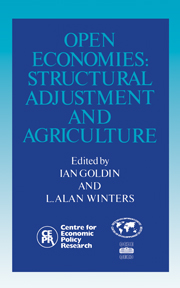Book contents
- Frontmatter
- Contents
- List of figures
- List of tables
- Preface
- Acknowledgements
- List of conference participants
- 1 Introduction: from macro to maize
- Part One Open economy analysis
- 2 Sequencing and welfare: labour markets and agriculture
- Discussion
- 3 Agricultural adjustment and the Mexico-USA free trade agreement
- Discussion
- 4 Do the benefits of fixed exchange rates outweigh their costs? The CFA Zone in Africa
- Discussion
- 5 Adjustment and the rural sector: a counterfactual analysis of Morocco
- Discussion
- Part Two The small country assumption and trade reform
- Part Three Risk and adjustment
- Part Four Government's role
- Index
3 - Agricultural adjustment and the Mexico-USA free trade agreement
from Part One - Open economy analysis
Published online by Cambridge University Press: 04 August 2010
- Frontmatter
- Contents
- List of figures
- List of tables
- Preface
- Acknowledgements
- List of conference participants
- 1 Introduction: from macro to maize
- Part One Open economy analysis
- 2 Sequencing and welfare: labour markets and agriculture
- Discussion
- 3 Agricultural adjustment and the Mexico-USA free trade agreement
- Discussion
- 4 Do the benefits of fixed exchange rates outweigh their costs? The CFA Zone in Africa
- Discussion
- 5 Adjustment and the rural sector: a counterfactual analysis of Morocco
- Discussion
- Part Two The small country assumption and trade reform
- Part Three Risk and adjustment
- Part Four Government's role
- Index
Summary
Introduction
On 10 June 1990, the presidents of Mexico and the USA agreed to negotiate a free trade agreement (FTA). Negotiations began in mid-1991, and were expected to be completed within about a year, implementation could start as early as 1993. The FTA would cap major structural reforms undertaken by Mexico over the last few years: trade liberalisation, domestic industrial deregulation and internal financial liberalisation, privatisation of public enterprises, and a successful renegotiation of the external debt.
One of the major issues is trade in agricultural products. Agricultural trade is probably the most distorted of all commodity flows taking place between the two countries. Moreover, agricultural trade intervention cannot be separated from domestic agricultural policies which, in turn, are intricately linked with politically volatile income distribution and labour market problems. This is especially important in Mexico, where land redistribution and agricultural regulation are an essential part of the heritage of the Mexican revolution. Agricultural reform will become necessary if a FTA includes agriculture. But the analysis of agricultural reform has to tackle the complicated interplay between efficiency losses and income distributional objectives underlying current agricultural policies.
Levy and van Wijnbergen (1991a) showed that land distribution and labour markets played an important role in determining the distributional impact of trade liberalisation in maize. Liberalising maize only would probably depress the demand for rural labour. On the other hand, fruit and vegetables, where the USA has trade barriers, is more labour intensive than maize. A comprehensive agreement might thus present less of a problem for rural labour markets than a liberalisation of maize alone.
- Type
- Chapter
- Information
- Open EconomiesStructural Adjustment and Agriculture, pp. 42 - 62Publisher: Cambridge University PressPrint publication year: 1992
- 2
- Cited by



